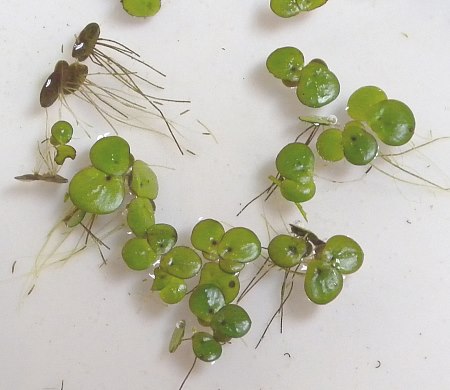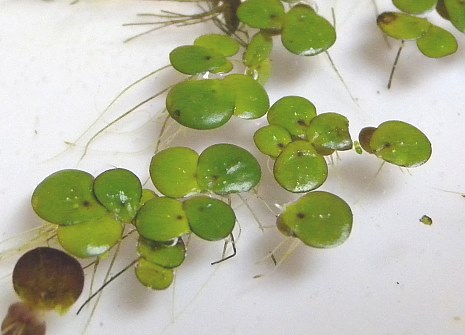
On rare occasions, tiny unisexual flowers are produced from 2 lateral pouches on the thallus. One pouch produces a single female (pistillate) flower, while the other pouch produces two male (staminate) flowers. A female flower consists of a single pistil, while a male flower consists of a single stamen; they have neither petals nor sepals. Both types of flowers are surrounded by tiny membranous spathes within their respective pouches. The blooming period can occur from early summer to early fall. The female flower is replaced by a tiny fruit (utricle) that is 1-1.5 mm. in length. This fruit contains 1-2 ribbed seeds. Instead of flowers, the lateral pouches more often produce vegetative buds that are connected to the mother plant by short slender stipes that soon wither away. A mother plant and its vegetative offspring may form temporary clusters of 2-5 thalli, but they eventually separate into individual plants. The root system of each plant consists of 3-15 rootlets that originate from a node on the underside of its thallus. These slender rootlets are up to 15 mm. long and their tips
Cultivation: The preference is full or partial sun on fresh water that is mildly acidic to alkaline. The water should contain some nitrogen and other nutrients. Great Duckweed thrives in locations with stagnant or slow-moving water that receive some protection from wind and waves. Sometimes it is cultivated indoors for aquatic terrariums.
Range & Habitat: The native Great Duckweed is occasional to fairly common throughout Illinois. It has a world-wide distribution, occurring in North America, South America, Eurasia, and other parts of the world. Habitats include quiet inlets of lakes, ponds, backwaters of rivers, creeks with slow-moving currents, and marshes. This aquatic plant is found in both sandy and non-sandy wetlands.
Faunal Associations: Many of the insects that feed on Lemna spp. probably also feed on Great Duckweed. Some turtles have been observed to feed on this plant, specifically: Chrysemys picta (Painted Turtle), Emys blandingii (Blanding's Turtle), Sternotherus odoratus (Musk Turtle), and Trachemys scripta (Slider). Similarly, the American Coot, Sora Rail, and several species of ducks also feed on this species, as do carp and probably other omnivorous fishes. Dense mats of Great Duckweed and their abundant rootlets provide habitat for tiny aquatic organisms of various kinds. Because the rootlets are somewhat sticky when they are wet, such animals as muskrats, beavers, and probably some wetland birds transport this plant on their fur or feathers from one wetland to another.
Photographic Location: The plants were observed at a sandy marsh of the Heron Boardwalk in Vermilion County, Illinois. The photographs were taken indoors.

Comments: Among plants in the Lemnaceae (Duckweed family), Great Duckweed is one of the easiest to identify because of the large size of its thallus and its abundant rootlets. In contrast, Lemna spp. (Duckweed) have only one rootlet per thallus, while Wolffia spp. (Watermeal) have no rootlets. Other distinctive characteristics of Great Duckweed include its red upper node, abundant veins of its thallus (5 or more), and the purplish red underside of its thallus. An introduced species in Illinois, Landoltia punctata (Asiatic Duckweed), can be distinguished by the smaller size and more narrow shape of its thalli; it also has fewer rootlets per thallus (typically 2-5). On the basis of genetic and other evidence, some authors have assigned species in the Lemnaceae to another family of plants (Araceae). Other common names of Spirodela polyrhiza are Giant Duckweed and Big Duckweed.